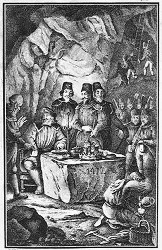Besucherbergwerk Fundgrube Weißer Hirsch
Useful Information

| Location: |
Kobaltstraße 42, 08289 Schneeberg.
Schneeberg. Auf dem Betriebsgelände der Bergsicherung Schneeberg GmbH. (50.5882327, 12.6374675) |
| Open: |
1st Sat in JUL, 22-JUL, 2nd Sun in SEP, weekend of Second Advent Fri-Sun 9-15:30. [2009] |
| Fee: |
Adults EUR 8, Children (3-18) EUR 5. [2009] |
| Classification: |
 Silver Mine Silver Mine
 Cobalt Mine Cobalt Mine
|
| Light: |
 Incandescent Incandescent
|
| Dimension: | |
| Guided tours: | D=120 min. |
| Photography: | |
| Accessibility: | |
| Bibliography: | |
| Address: |
Sächsicher Bergbauverein "Weisser Hirsch Schneeberg" e.V., Kobaltsstraße 42, 08289 Schneeberg, Tel.: +49-3772-290.
E-mail: |
| As far as we know this information was accurate when it was published (see years in brackets), but may have changed since then. Please check rates and details directly with the companies in question if you need more recent info. |
|
History
| 1477 | specimen of solid silver, two metres long and one metre high, discovered in the St. George mine. |
| 1481 | Schneeberg is elevated to city status. |
| 22-JUL-1496 | the "first rising" of the miners in the fight for fair wages, day is still celebrated today as Bergstreittag. |
| 1654 | Weißer Hirsch mine first mentioned in documents as a cobalt mine on the St. Georg Flacher and Walpurgis Flacher ore mines. |
| 1850 | Old shaft abandoned and the current drift shaft sunk. |
| 1880 | merger of all Schneeberg mines to form the "Gewerkschaft Schneeberger Kobaltfeld". |
| 1890 | the water powered elevator is replaced by a two-cylinder steam engine. |
| 1912 | Steam engine replaced by an electrically powered hoisting machine. |
| 1935 | Mining by Sachsenerz AG. |
| 1945 | Uranium mining by SDAG Wismut. |
| 1957 | Mining in Schneeberg ceases. |
| 1994-1996 | Huthaus and Treibehaus reconstructed by the Schneeberg mining safety organisation in accordance with monument protection regulations. |
Geology
Silver and cobalt ore was mined here, which became particularly famous for the discovery of many new minerals. The St. Georg, St. Niclas Flacher and Walpurgis Flacher veins, which are located in the area of the show mine, are well known to mineralogists all over the world. The veins often contain the words Flacher and Stehender in their names. This actually refers to the position in the rock, i.e. the dip; flat ones dip at less than 45°, standing ones at more than 45°.
Description
The show mine Fundgrube Weißer Hirsch is located in the heart of the historic mining area Schneeberger Bergrevier. It is the type locale of at least 22 uranium, bismut and cobalt minerals. In total, 170 different minerals were found here.
The most important event with this mine was the discovery of a single block of silver in 1477, two meters long and one metre high. It was called the Silbertisch (table of silver). It became so famous, even Herzog Albrecht von Sachsen and his court entered the mine to see this extraordinary find. They sat at the table having a meal. The silver was coined into 80,000 Gewichtsmark, each containing 0.24 kg pure silver, a total of 20 tons of silver.
But even more important was the discovery of the lode Walpurgis Flacher on the 16-MAR-1871. The lode consisted of weathered uraninite and pure bismuth. It was coloured in orange, yellow and deep green by secondary uranium minerals. The mineralogist A. Weisbach at the Bergakademie Freiberg (Mining University Freiberg) discovered five so far unknown secondary uranium minerals. The mine is type locale for those minerals.
The mine is developed only in a very low manner, it is secure and cleaned, but rubber boots, helme, headlamps and miner garment are necessary. The path is dirty and slippery, the ceiling often low and the tunnels narrow. The tour enters the mine in the entrance building called Huthaus, and descends with a Fahrkunst (mine elevator) to the Tiefer Fürstenstolln, a level 50 m below ground. Here tunnels of the Middle Ages, different mining techniques and remains of the lodes with colourful minerals can be seen. Typical equipment and tools are also on display, such as Fahrten (ladders), arse leather, hunts, Schlägel und Eisen (hammer and chisel). The mine has very unusual opening hours, as it is only open three times a year for local mining festivals. These are the Miner’s Day on the 1st Saturday in July, the Schneeberg Mining Day on 22nd July and the Schneeberg Light Festival on the 2nd weekend in Advent, when the mine is open from Friday to Sunday. The mine has also been open several times in recent years on Open Monument Day in September.
 Search DuckDuckGo for "Besucherbergwerk Fundgrube Weißer Hirsch"
Search DuckDuckGo for "Besucherbergwerk Fundgrube Weißer Hirsch" Google Earth Placemark
Google Earth Placemark OpenStreetMap
OpenStreetMap Besucherbergwerk Fundgrube Weißer Hirsch, official website
Besucherbergwerk Fundgrube Weißer Hirsch, official website  (visited: 04-JUL-2025)
(visited: 04-JUL-2025) Index
Index Topics
Topics Hierarchical
Hierarchical Countries
Countries Maps
Maps